Peinture participative et générative
Marché des Grésilles
Dijon, France 03/2016
4 jours avec 30 participants – projet organisé par Zutique avec la participation des enfants de la MJC et du centre social des Grésilles.
Peinture participative et générative
Marché des Grésilles
Dijon, France 03/2016
4 jours avec 30 participants – projet organisé par Zutique avec la participation des enfants de la MJC et du centre social des Grésilles.
4th Biennale d’Art Contemporain
Le Havre, France
September 28th 2012 – May 15th 2013
Directed by Linda Morren and curated by Kevin Grottaglia
I built the Signalétique Libre (free signage) installation exclusively for the Le Havre Contemporary Art Biennial. It will be exhibited on the Jules Ferry square until May 15th 2013.
My idea was to take advantage of the location, a wide open space and very transited – which means a significant pedestrian flow and enough wind – to do a mobile installation. The work was conceived around an idea I have already worked with several times: give the spectator, each time they see the artwork, the possibility to see new compositions. Signalétique Libre questions urban visual communication – very direct, concise and at times even alienating – concentrating in the same reduced space 20 signs with abstract designs, without any intelligible message, that remained in constant motion. The pedestrian is free to interpret what the signs want to communicate or indicate, an open space for the viewer to stop receiving messages and perhaps start to emit them.


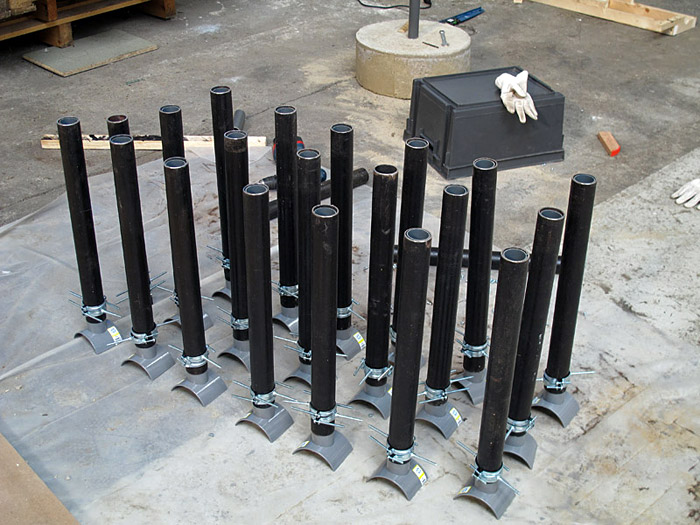




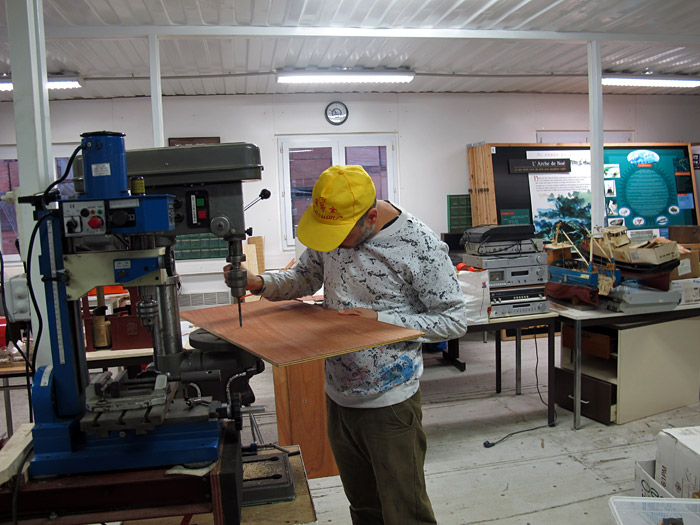

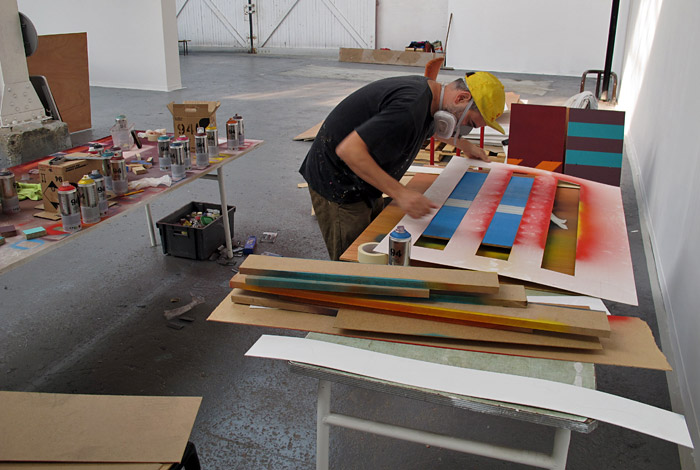
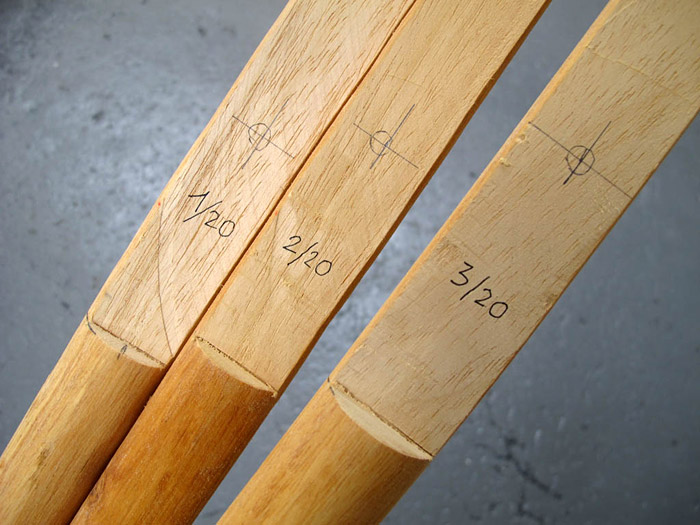







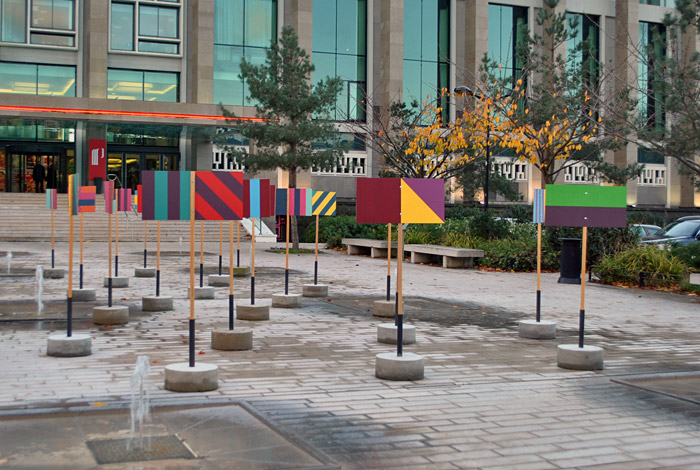















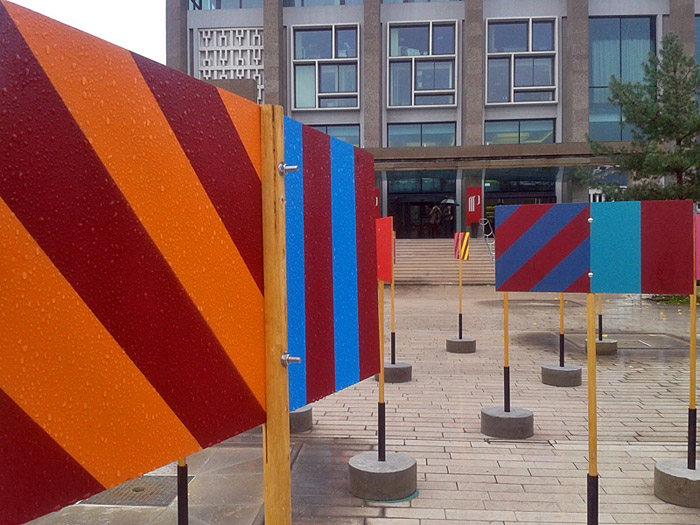
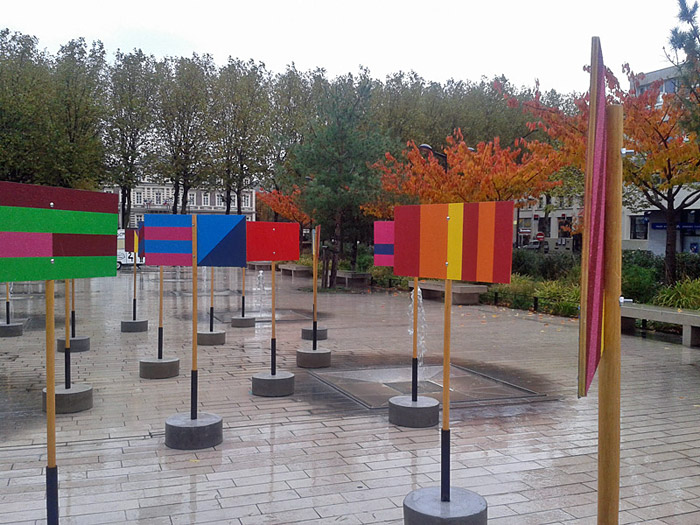

Exterior pictures by Mikaël Lesueur
Thanks to Linda Morren, Kevin Grottaglia, Mikaël, Paul and all the crew at the Musée Maritime et Portuaire du Havre.
Ongoing project
Started in September 2011
I have always been fascinated by all the marks, traces and treads that our daily movements leave throughout a city. The idea behind TRACES is to observe and somehow try to register these types of marks. For this purpose, I am working on some experiments that allow for the possible appearance of shapes and lines by exploiting these daily movements.
The first experiment is called Gravure au sol (ground engraving). The idea was to generate graphic works using the city as a studio. The four first attempts with a satisfactory result were executed on the asphalt of three streets (one in France and two in China) registering the passage of cars, motorbikes, bikes and a few pedestrians.

Asphalt engraving on card, 18 cm x 28 cm.
13/09/2011 from 14h25 to 20h20, road D54, France.
Most of the marks were left by cars.

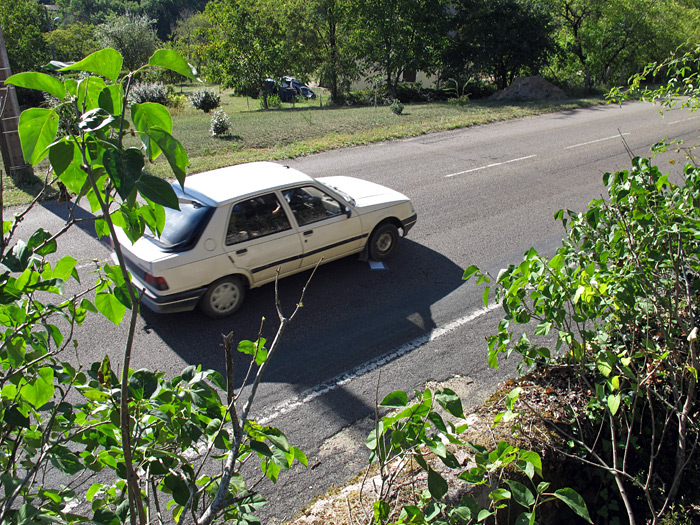
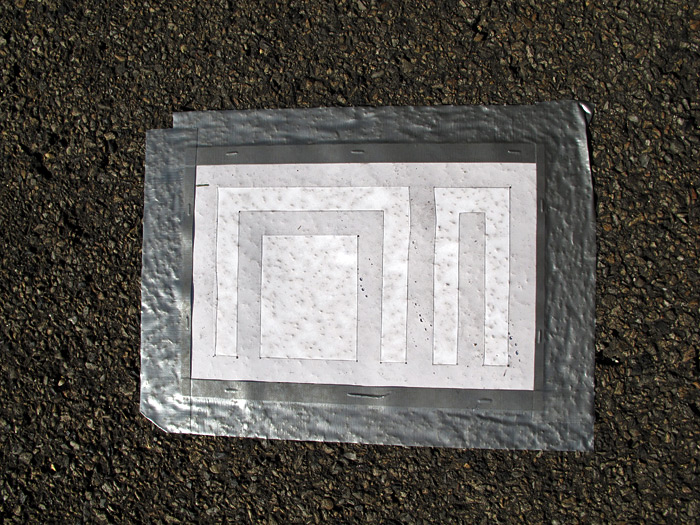




Asphalt engraving on Canson Paper, 18 cm x 28 cm.
14/09/2011 from 9h32 to 16h54, road D54, France.
Most of the marks were left by cars.








Asphalt engraving on Sumiaozhi-8K 160g Paper, 18 cm x 28 cm.
19/10/2011 from 15h00 to 16h19, 学院路 (Xueyuanlu), Beijing, China.
Most of the marks were left by bikes and bicycles.













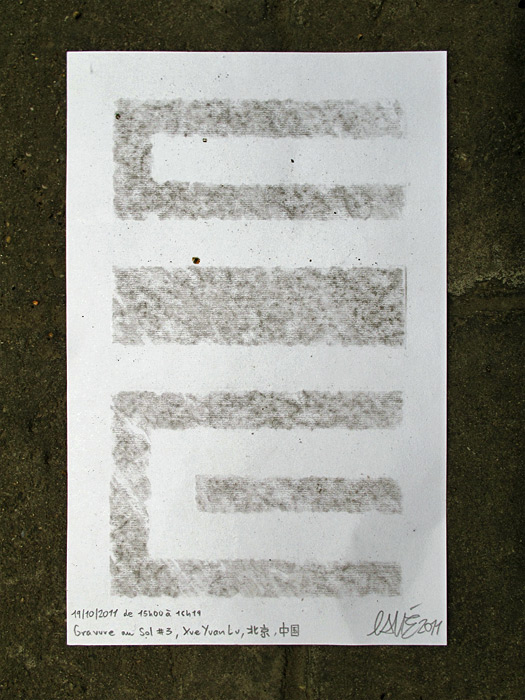
Asphalt engraving on Sumiaozhi-8K 160g Paper, 18 cm x 28 cm.
24/10/2011 from 15h48 to 16h45, 展春园西路 (Zhanchunyuanxilu), Beijing, China.
Most of the marks were left by cars.





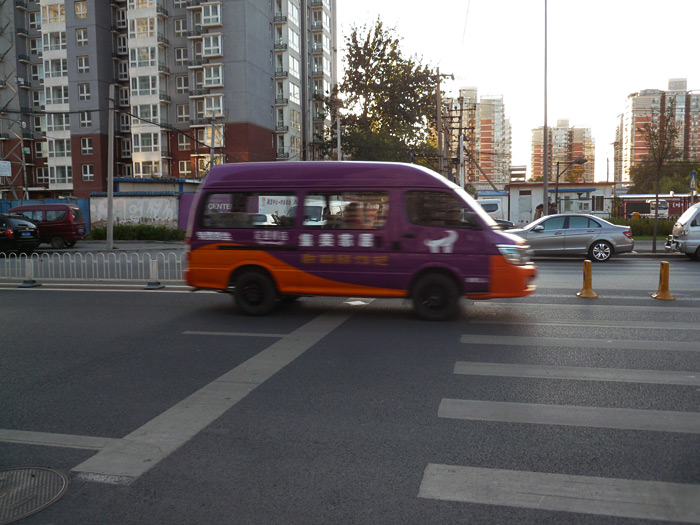







I am in the process of conducting further experiments at this time. As soon as I obtain some more interesting results, I will post more examples.
As the results for these first experiments from the TRACES project are recoverable, they will be available for purchase, with my other graphic works, at the Boutique on this website.
Art Re-Public Festival
Yoyogi Park, Harajuku,Tokyo, Japan
May 5th 2011
My last visit to Japan coincided with the Art Re-Public festival organized by my friend Yusaku. Over the past few years this festival has taken place in the streets of Tokyo to celebrate “Kodomo No Hi” or Children’s Day, an annual celebration throughout Japan. This year however, the festival took place in Yoyogi park in Harajuku.
I was offered the opportunity to do an installation at the event and decided to take advantage of the presence of so many children to do an experiment with one of my automatic painting projects. Four stations were prepared where people (mostly children) could choose randomly between 9 figures, 6 colors, 8 orientations and 289 positions. This choice was determined through a series of simple games. The experiment lasted 5 hours during which 85 people participated and 86 figures were painted.



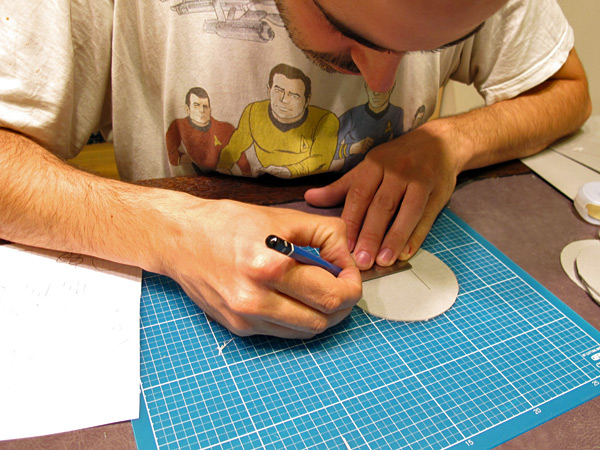














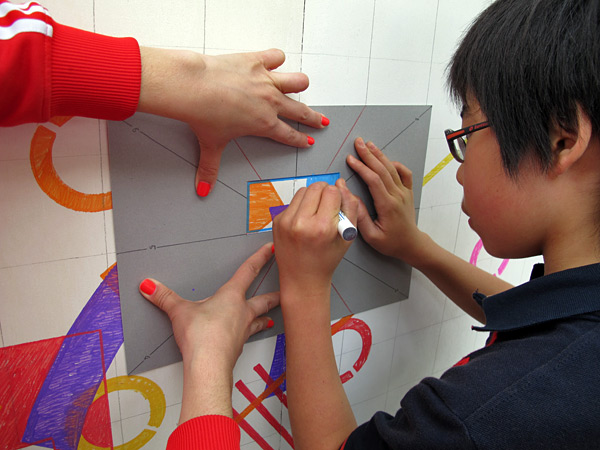
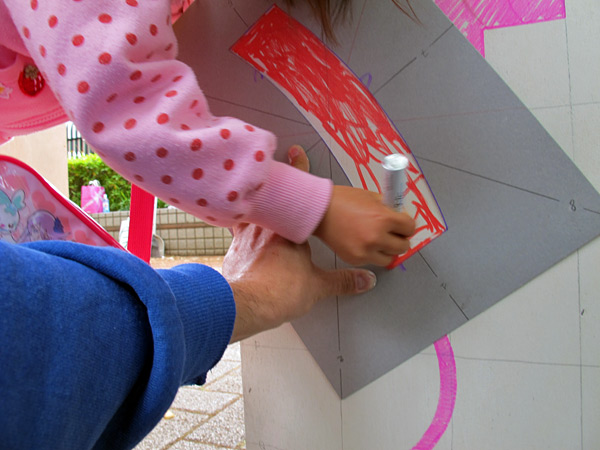




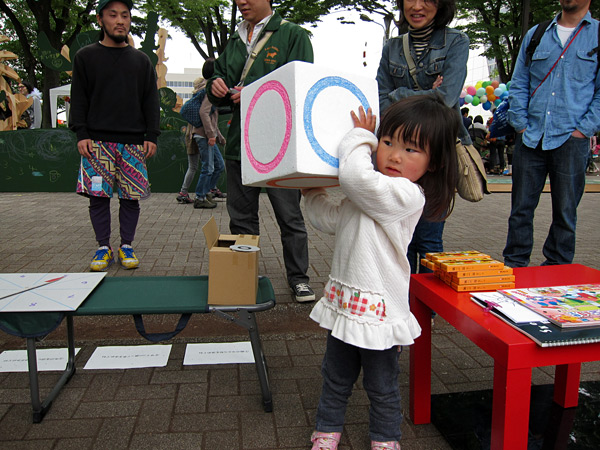















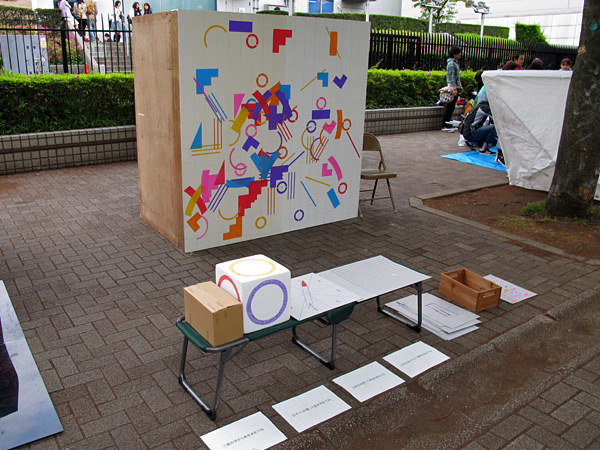




This project would not have been possible without the help of Sierra Forest and the invitation and hospitality of Yusaku and his family. Thanks!
Muban (木板, “wood board” in Chinese)
Urban drift experiment with wooden boards
Beijing, China 2011 – 2013
Muban is an experiment about movement and material recuperation. Since I moved to China, I have been observing how people constantly recycle everything – from cardboard boxes and plastic bottles to bricks, doors and windows from demolished buildings. These materials are immediately collected and sold by the kilo or directly reused. I wanted to see what would happen if I threw my own material out onto the street. where would it end up? How would it be used? I bought some thin plywood boards, and had them cut (81 x 61 cm). On either side of each board I painted white shapes to be able to spot them easily. Each board was given a slightly different design so I could differentiate and follow them. Then, I left them in the street and waited to see what would happen.
One day on my way to my daily Chinese classes, I found a shortcut passing through a “hutong” neighborhood. I found it so interesting, compared with the rest of the over-urbanized area around, that I decided to pass through there everyday. The people living there were very kind, always smiling and open to communication. I decided to do the first Muban experiment in this neighborhood because it was quite small, had one story homes and very few residents lived there. Furthermore, as I was walking or biking through it everyday, I would be able to observe the pieces and how they moved twice a day. I prepared the first nine Mubans in my studio and one night, I deposited them around the tiny hutong streets. I distributed the boards into four sets: one containing three boards and the other three containing two. They disappeared very fast and, only once (18 days later), was I able to see a set of two boards (A6 and A7) reappear again in an adjacent street before it was completely gone. I abandoned the nine boards in November of 2011 and I continued to observe until the summer of 2012. Today this neighborhood is almost completely gone. Most of the people have lost their homes and have been forced to move somewhere else in order to build more towers and skyscrapers.
Click on the images to enlarge them and read the captions to follow the story.
Muban A1, A4 and A5:
Muban A2 and A9:
Muban A3 and A8:
Muban A6 and A7:
This is how this hutong neighborhood looks today (June 2013). In almost every picture you can see some tall buildings surrounding the area – this is what they’ve planned to build here, more towers, once the last residents have been kicked out.
Things got a little bit better with the second experiment, I got a couple of very interesting results and I was able to draw a map of the movements. I painted nine boards again and I deposited them, one by one this time, in a small residential area very close to my house. Since then, I have walked around or biked through this neighborhood almost everyday trying to spot the boards. After so many hours observing and looking for the white geometric designs, I developed a new ability and was able to detect them quite easily.
Click on the images to enlarge them and read the captions to follow the story.
The records of Muban B1 to B9 are presented in chronological order.
Muban B1:
Muban B2:
Muban B3:
Muban B5:
Muban B4:
Muban B9:
Muban B8:
Muban B6:
Muban B7:
I learned many interesting things while doing the Muban project such as how to be discreet to avoid ruining the experience, how to appear lost when you know exactly where you are going and a variety of interesting habits and quirky personality traits belonging to the Beijingers who live in these communities. This experiment is an ongoing project. The pieces must be observed for a very long time so it’s not an easy project to start just anywhere. I’m looking forward to continuing with it and I hope to be able to report more results. If by any chance, any of the above listed Mubans reappear, I’ll post the update here.
Festival Of World Cultures
Dún Laoghaire, Dublin, Ireland
July 23rd – 25th 2010
In June of 2010 I was invited by the Festival of World Cultures to reconstruct my Astillas instalation. It was first presented in La Culpable galery in Lima in June of 2008 (www.eltono.com/en/exhibitions/astillas). The event lasted 2 days and thanks to the constant public participation, the instalation was ever-changing and new compositions were created constantly.












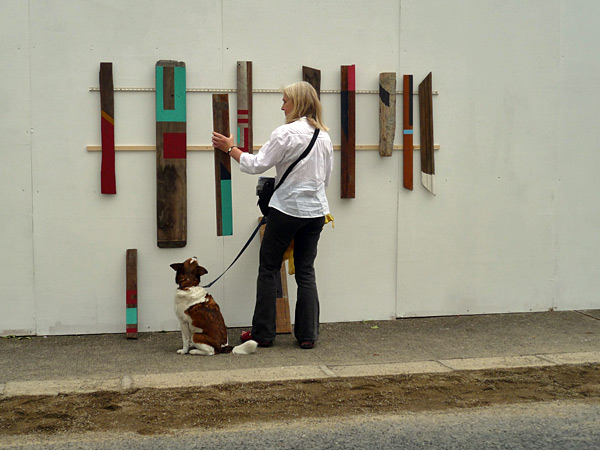




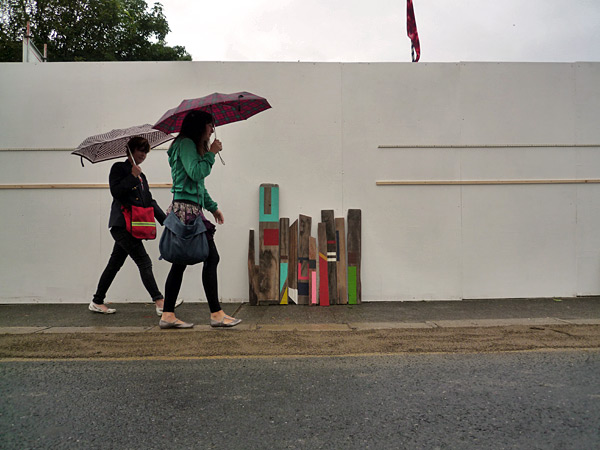



All of a sudden a carnaval began in front of the instalation!




In honor of the land where the instalation was first conceived, I decided to send one of the wood chips “back to Peru”…
:)






In these images below, you can see a selection of the compositions done by varios people throughout the festival.
Thank you very much Jane, Jules and Anja.
Sala de Arte Joven de la Comunidad de Madrid
Av. América 13, Madrid
De abril a agosto 2010
Comisariado por Isra Souza y Rafafans
El proyecto se basa en materializar en un espacio físico, como es la Sala de Arte Joven, la gran fuerza de las dinámicas relacionales que se experimentan en las redes sociales de internet y la llamada web 2.0.
Portales como Facebook, Tuenti, Myspace o YouTube, se crearon como “páginas blancas” con una arquitectura capaz de incorporar las aportaciones de los usuarios. Son los usuarios los que aportan el contenido y, a la vez, otros usuarios los consumen y tienen capacidad de sobreescribirlos, incorporarlos y modificarlos, generando otro tipo de valor.
Estas herramientas de producción del saber colaborativo (cuyo arquetipo es la Wiki) afectan de una forma muy profunda y duradera la manera en que se puede producir la cultura. Y eso no sólo se tiene que aplicar en el mundo de internet. Se trata de una verdadera revolución en el modelo de producción, un cambio profundo en la estructura del modus operandi de una sociedad y sus dimensiones culturales, sociales y económicas, basados en unos nuevos principios de la competencia, como son la apertura, el intercambio y la acción global.

Los artistas participantes en esta experiencia son Jacobo Castellano, Pablo Grandegraphix, Eltono, Juan López y Nano 4814. Todos ellos trabajan con unos formatos y tipologías de obra en la línea de las intervenciones artísticas en espacios específicos (site specific), con un lenguaje muy escultural, lo que posibilitará la materialización formal de esta experiencia en la Sala.
En esta ocasión, los artistas actúan como “webmasters” para dirigir, coordinar y gestionar las acciones y tareas necesarias para la producción de una obra artística mediante la actuación de un grupo colaborativo de usuarios/consumidores de cultura.
Es decir, que la Sala de Arte Joven se transforma en una plataforma de participación social, en un proceso por el cual, los propios usuarios y consumidores de cultura tienen posibilidad de participar en la producción del propio “producto artístico” a través de una red social colaborativa dirigida por los artistas, cuyo objetivo es materializar en una “obra de arte global” las dinámicas relacionales de internet.
De abril a julio de este año, los grupos de trabajo se sucederán en el montaje de sus instalaciones, en un proceso acumulativo, de tal forma que el material producido por un grupo será contenido de reflexión y actuación del siguiente, estableciéndose así un diálogo (o metadiálogo) entre todos los participantes. Este modelo de conversación, en una dimensión superior a la del propio acto de producción, es el reflejo material de los nuevos paradigmas de la web 2.0.
El resultado final de todo este proceso participativo, se podrá ver durante los meses de julio y agosto y será una “obra de arte global” que materializa varios conceptos básicos de un proceso de co-creación: la inteligencia colectiva, la disolución de la autoría y la democratización de la cultura.
Gracias a la increíble ayuda de mi grupo de trabajo (participaron en total más de 20 personas), desarrollamos 7 proyectos en la sala.
Enlaces directos a las galerías de fotos:
1 – Script 1.2
2 – Confeti v2
3 – Astillas 2.0
4 – Ropa de Trabajo #3
5 – Vitrina/Muro
6 – Pintura Invisible
7 – Torno Cromático
El primer experimento, Script 1.0, tuvo lugar en el Centro Cultural de España en Buenos Aires en abril del 2010. El Script 1.1 en galería Delimbo en Sevilla en abril. Con la misma idea inicié Script 1.2 para la expo Sala de Arte Joven 2.0. Se trataba de pintar la pared más grande de la galería entre todos los participantes del grupo de trabajo. Cada colaborador tenía un color asignado y tenía que pintar rayas según unas normas precisas y así se hacía ejecutor del script y a la vez espectador de como se iba pintando “automáticamente” el mural.
Marcamos una cuadricula en la pared y cada colaborador eligió su color. Antes de empezar a pintar se iba sorteando las coordenadas de cada línea (x,y) para saber su punto de arranque y su dirección.
Entre 12 personas pintamos 30 líneas de 12 colores distintos en 7 días.



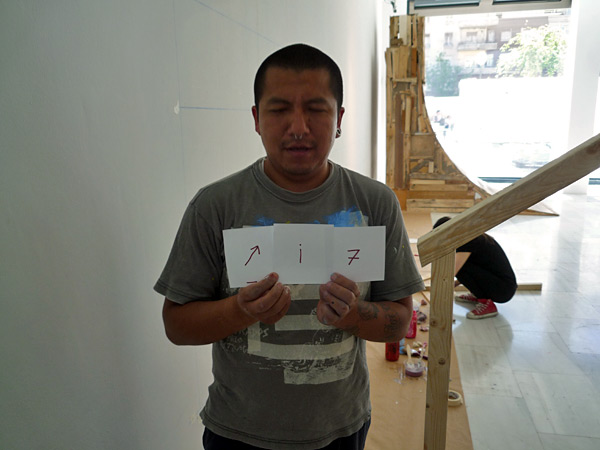
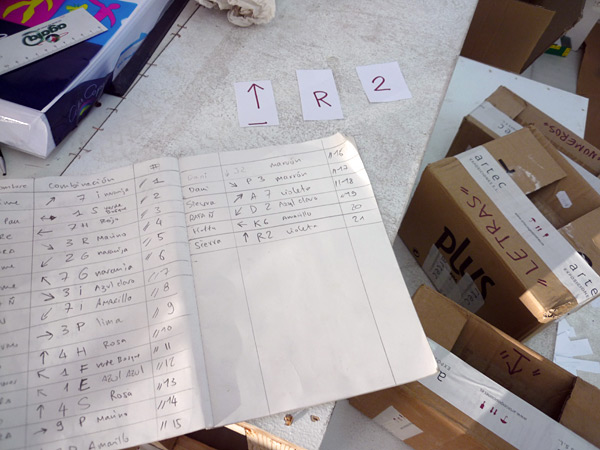


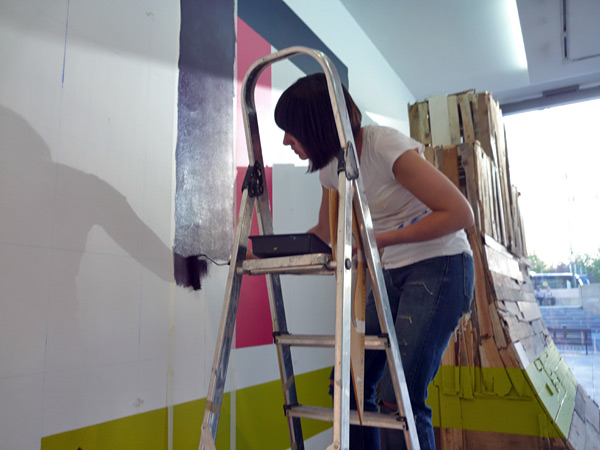



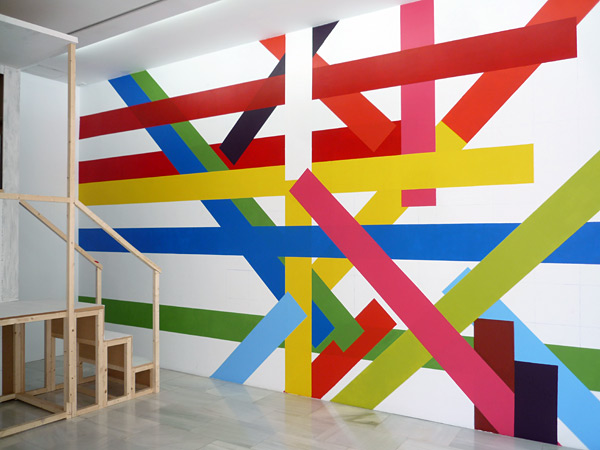





Video:
Un aspecto importante de esta exposición era la posibilidad (o el deber) de reutilizar las obras de los artistas anteriores. Antes de mi, Pablo Grandegraphix, por una magnifica casualidad uso uno de mis materiales preferidos, el confeti!
Marcamos una cuadricula en la pared de la sala de arriba, definí las formas geométricas que se podían usar y con unas reglas sencillas los colaboradores prepararon la pared con cinta doble cara. Fue muy interesante ver como los colaboradores interpretaron mi trabajo a su manera, de todo el proyecto, es la obra que más me sorprendió.



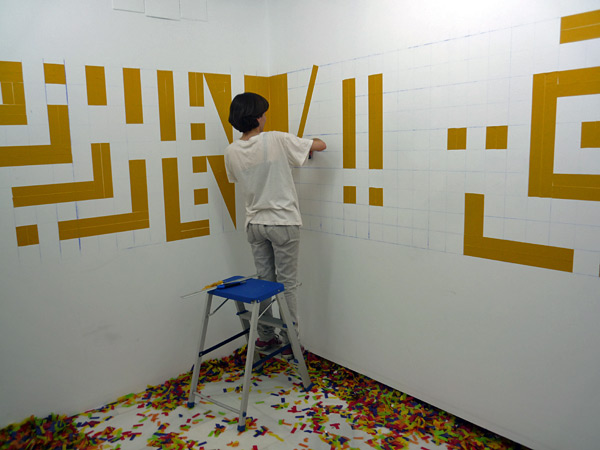





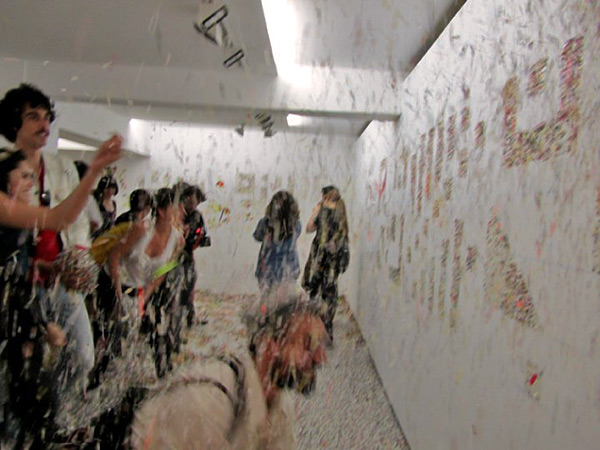
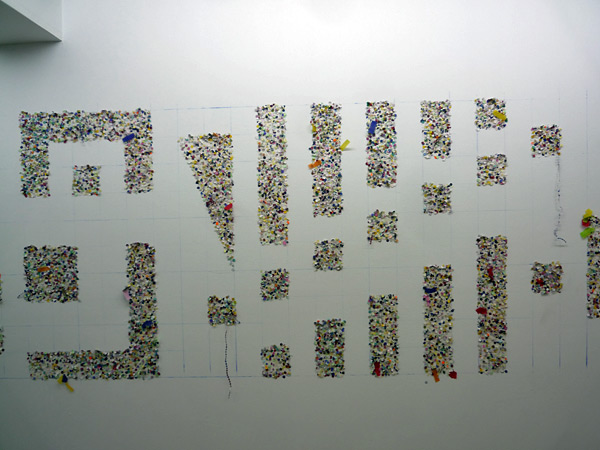
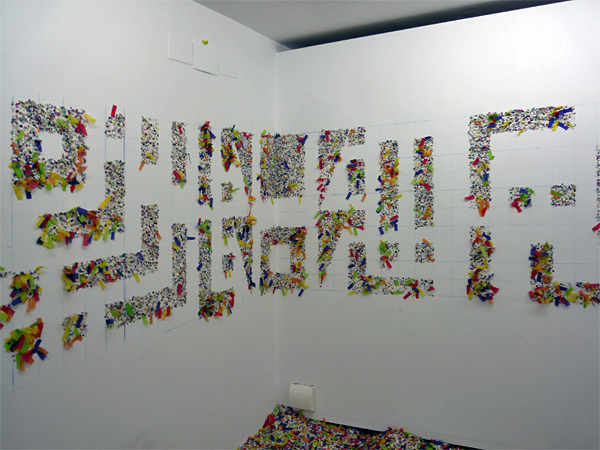




Retomando el concepto de la exposición que presente en Lima en junio del 2008 (www.eltono.com/en/exhibitions/astillas) hicimos literalmente astillas con las instalaciones de los artistas anteriores. Cada colaborador tenía que seguir unas reglas sencillas (solo podían pintar tres formas geométricas utilizando un máximo de tres colores planos) y fueron recortando y pintando piezas de madera para la creación de una obra grande interactiva que se fue formando y modificando según los aportes de cada colaborador. De esa forma con cada obra particular se construyó una gran obra global de la que nadie podía controlar el avance. Una vez la exposición abierta al público, la obra podía seguir siendo modificada por los visitantes.








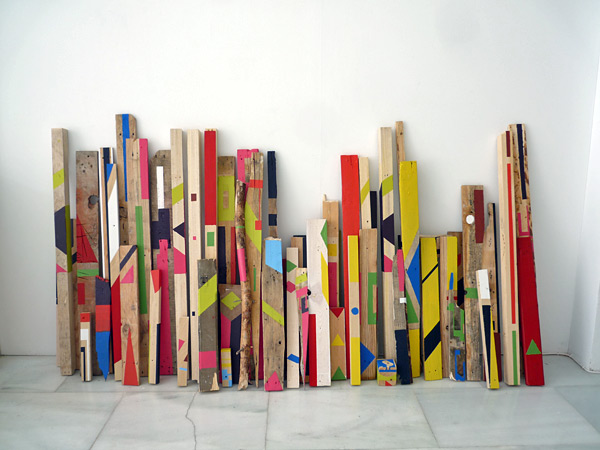




Cada colaborador tenía que venir con ropa de trabajo que se podía ensuciar y de esa forma entraba a formar parte de R.D.T #3.

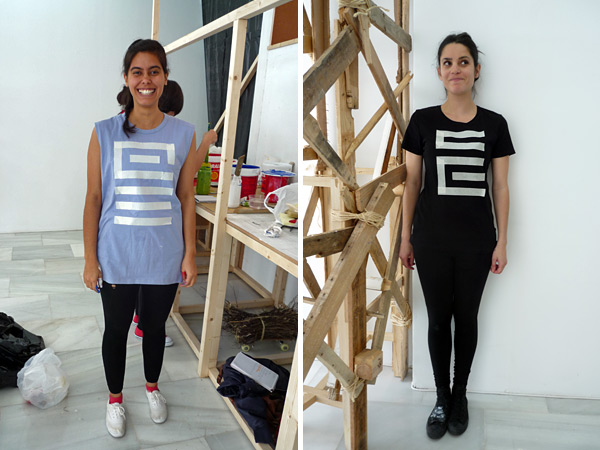













La idea era de pintar la vitrina con blanco de España y utilizarla como un muro donde cada uno pueda escribir con el dedo en su parte exterior. Como en las redes sociales, los colaboradores podían escribir libremente en la vitrina/muro y poco a poco se fueron sumando los espontáneos de la calle que también iban dejando sus mensajes.




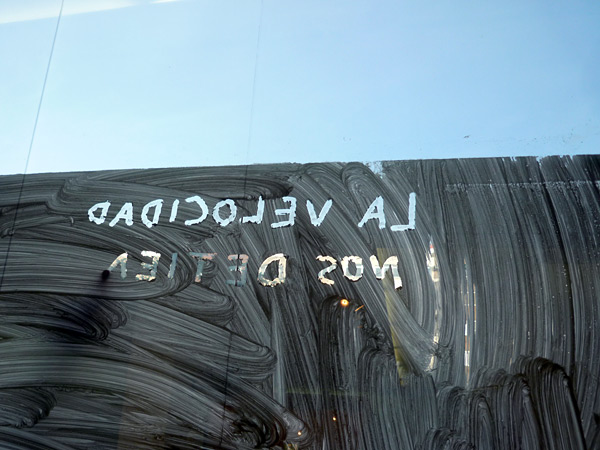











Cuando invité a Julio Jara para participar en la exposición como colaborador, enseguida me propuso hacer una intervención con sus alumnos del taller “A Ciegas” (un taller de performance para personas ciegas o con deficiencia visual). Intervinieron el día de la inauguración en la sala de arriba y, vestidos con monos blancos, exploraron el espacio con sus bastones convertidos en pinceles. De esta forma, se realizó un mapa del espacio explorado a través de la imagen abstracta.
Más info: www.hablarenarte.com
Como última pieza, reutilice el torno que Jacobo Castellano construyó inspirándose en los tornos de los claustros de monasterios. Lo transforme en un instrumento de mezcla cromática desviándolo totalmente de su inspiración inicial.



Muchas gracias a: Carmen y Tono (el verdadero), Julio, Ana Paula, Jaime, Clara, Hoffa, Lore, Mónica, Rafa, Rocío, Guillermo, Pablo, Laura, Dani, Sierra, Tere, Bea, Elsa, Parsec, Jesús, Alvaro, Dane, Isra, Rafafans, María, Pepito, Encarna Fernández, Justo Sánchez-Manzano, Ana Isabel Illanes, Emilio Camacho, Eduardo de la Fuente…
MUAU
Fundación Caixa Galicia, La Coruña, Spain
April 15th – June 27th 2010
I first presented the project Branco de España during the Postgraffiti, Geometría y Abstracción exhibition curated by Javier Abarca at the Fundación Caixa Galicia during the MUAU in A Coruña.
This is another experiment like Pubblico, Coriandoli or El Autotono where the final result of the artwork is completely dependent on pedestrian interaction. In this project the basis of my interest and observation was the combination of random organic drawings with my clean, calculated designs. People drew with their fingers slowly revealing my hidden images.
You can see the video first by clicking here.





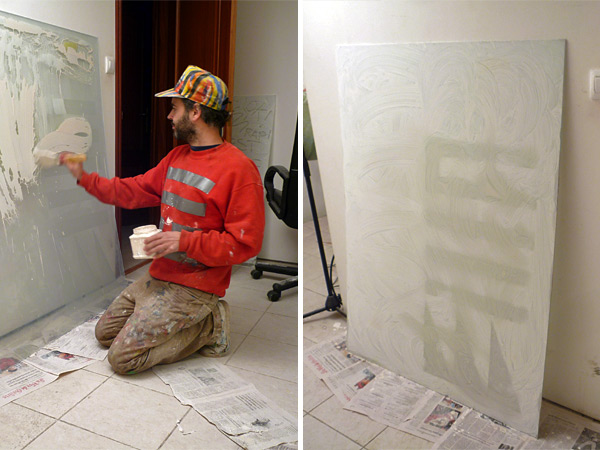





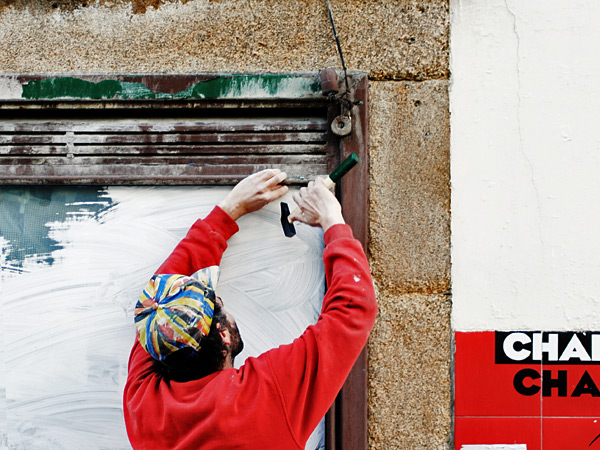
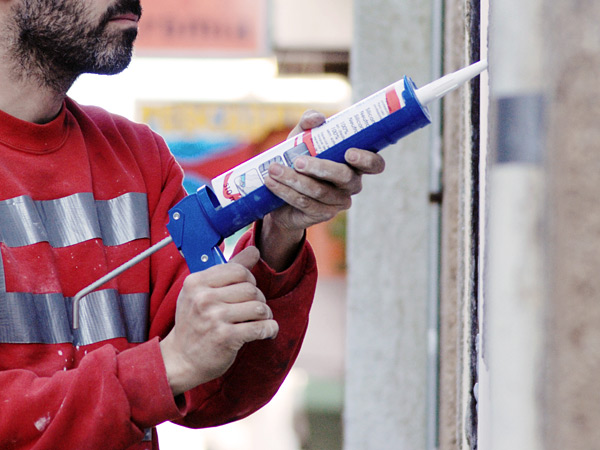






















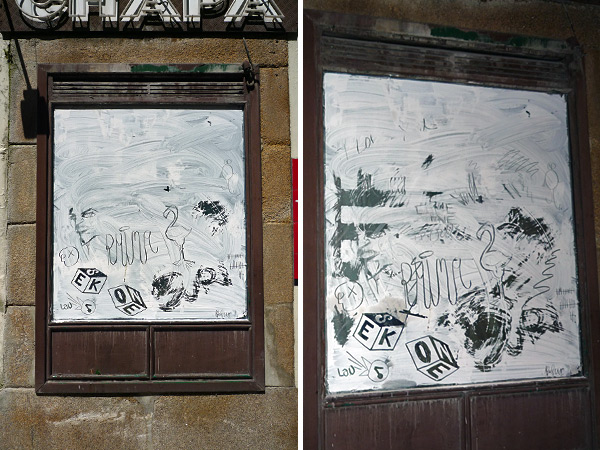

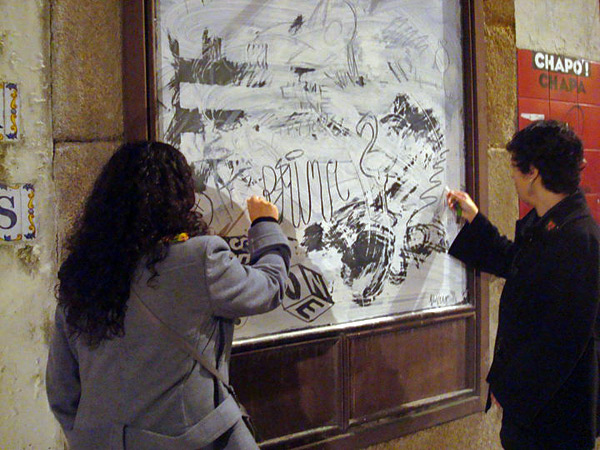




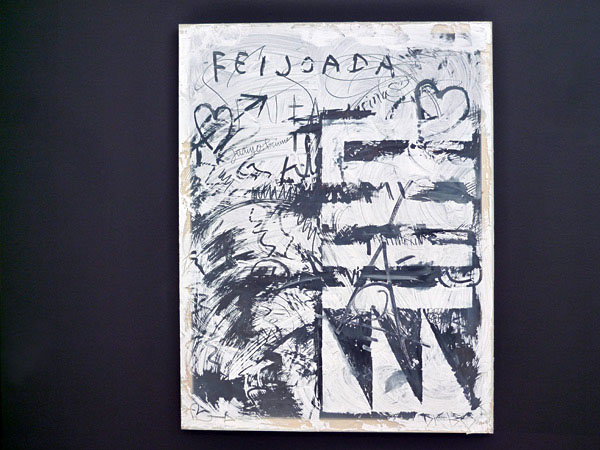





This is the video that was shown in the gallery. It was filmed and edited by M.A. Barrigüete.
Thanks to all the amazing people from the MUAU, Javier Abarca for giving me the opportunity to partake in this exhibition, and Henry Chalfant for his great conversation, insight and company.
Pictures by Elba Fernández, M.A. Barrigüete and Eltono.